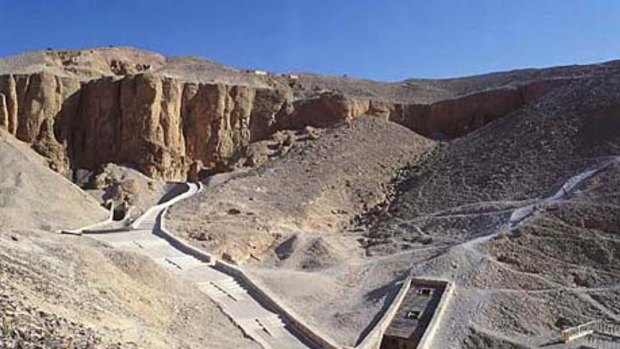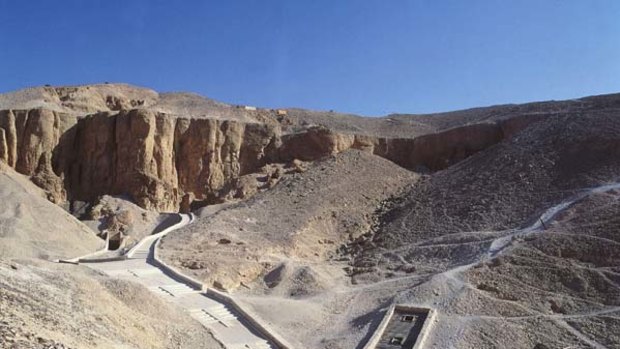
Dynasty days ... royal tombs at the Valley of the Kings.Credit: AFP
The Book of the Dead can be found on tiny ancient temple walls, in sarcophagi and on precious rolls of papyrus, if you knew where to look, writes Sophie Campbell.
SHE was lying on her back at the bottom of the sarcophagus, legs pressed together under a fitted tunic, arms by her sides, bobbed hair immaculate, gazing skywards like a sunbathing tourist. This was Nut, the Egyptian goddess of the night, who swallows the sun every evening and gives birth to it again every dawn. She was very beautiful and her tunic was sprinkled with stars.
"That's a mirror you're looking at," said Khaled, an Egyptologist and guide, as we squatted by the stone sarcophagus in the Cairo Museum. "She's actually carved on to the lid."

Dynasty days ... royal tombs at the Valley of the Kings.Credit: AFP
I tried not to look startled. Nut had been imprisoned in darkness for 3000 years or more, staring not up at the sky and stars but down at a mummy-form coffin. It gave me an odd sensation - part claustrophobic, part morbid fascination - that seems to lurk about ancient Egyptian history.
Khaled had four days in which to explain the Book of the Dead, the subject of an exhibition opening at the British Museum in November, which covers millenniums of Egyptian royals.
We were flying from Cairo to Luxor, driving back via Middle Egypt and visiting Book of the Dead wall paintings along the way.
The Book of the Dead is not a book. It's a body of spells derived from the earliest incantations spoken by priests into the mouth of a mummy before its burial. As the centuries rolled by, the spoken spells - designed to protect the deceased from evil on its journey through night into the afterlife - became written; first on pyramid walls, then in sarcophagi and, later, on papyrus rolls.
The British Museum has a stupendous collection of these rolls, which will form the backbone of the show. And Nut makes an appearance in chapter 122.
The trouble is, you could spend a week in the cavernous Cairo Museum of Antiquities, founded by a Frenchman in the 19th century and holding the largest collection of Egyptian artefacts in the world.
"I'm concentrating on the 18th dynasty," Khaled announced, dismissing roomfuls of magnificent treasures, including Tutankhamun's death mask, gold funerary objects and 130 walking sticks (he may have died of gangrene of the leg), with a firm wave. "That's the beginning of the use of the Book of the Dead and also the time that the Valley of the Kings came into existence."
It was also the first dynasty of the New Kingdom; the peak of ancient Egyptian cultural achievement.
So, as everyone else queued for King Tut, we stared at the fine features of Amenhotep IV, an interesting chap who renamed himself Akhenaten, replaced the sun god Ra with a deity visible only to him, sacked 1500 priests and frequently had himself depicted as a woman. With his son, the boy-king Tutankhamun, and other star pharaohs of the New Kingdom (circa 1500BC-1000BC), they buried themselves not in pyramids, as their Old Kingdom ancestors did, but in deep chambers reached by sloping shafts. We now call this the Valley of the Kings, near Luxor, and several of the shaft walls are painted with chapters from the Book of the Dead.
Outside the vast pink museum, Cairo was heating up for the summer. Fading apartment blocks slumbered in the shade of acacia trees, traffic glittered and roared around the ring roads and there were small canals everywhere, fringed with litter and mudbrick houses. Donkeys tripped along, laden with bundles of alfalfa or with children who tapped them absent-mindedly with sticks as they went.
In the Dandy Mall, one of the city's colossal airconditioned complexes, I ate in a perfect facsimile of a traditional Egyptian restaurant, where the waiter fretted that it was late in the pigeon season: wouldn't I find them too small? They were tender, stuffed with rice, accompanied by molokhia (spinach soup) with rabbit and Circassian chicken with walnuts and washed down with a small bottle of beer. It was like being teleported to the desert. As I ate I mulled over the trip. It would not be chronological; we would move back and forth between Middle and New Kingdoms with extra bits - such as climbing into one of the earliest intact pyramids at Dahshur - unrelated to our theme but added in for fun.
We would see the process of "democratisation", which meant that pharaohs no longer had exclusive rights to resurrection, nor to using the Book of the Dead in their burial sites. Wealthy commoners, if they could afford it, could commission tomb decor using a papyrus pattern book of text and vignettes.
On the flight south to Luxor, the real desert stretched as far as the eye could see. Below us the brown rope of the Nile slid north. At Luxor, the river eased past the hotel, laden with triangular-sailed feluccas floating sideways like ducks, giant river cruisers and fishermen. At dawn, hot-air balloons hung over the west bank and the Valley of the Kings.
In 1991, archaeologists found Deir el-Medina, a village just south of the valley, where craftsmen working on the temples lived with their families. It's one of Khaled's favourite places in Egypt, partly because of its tiny temple, which was buried in sand and so remained untouched by Christians or 19th-century explorers and has wall paintings in colours as good as new.
Outside, an elderly guardian held a piece of polished metal to bounce the sun on to the paintings. In the wavering beam, Horus and Anubis - falcon and jackal - presided over a pair of scales, weighing the heart of the deceased against a feather. If heavier, the heart was eaten by a crocodile. If lighter, the deceased joined Osiris in the afterlife.
A baboon scribe waited to record the result and blue-skinned Osiris sat on his throne, with crook and flail, watching. "It thrills you," Khaled said simply. "The colours and stories are so perfect. This is the only place that you can find all the details of the final trial."
We walked past the maze of mudbrick walls that once housed hundreds of workers, to a richly painted underground tomb so fragile that visits are limited to 10 minutes.
Inside, there was a power cut. I found it rather a relief: two days and my brain was already spinning with baboons, sun discs and cross-dressing pharaohs. Kingdoms and dynasties eddied and clashed. My notebook teemed with wobbly drawings and frantic questions I hoped to look up later. All I knew for sure was that the favourite food of the Egyptian gods was lettuce.
It was worse in the Valley of the Kings because Khaled didn't come into the tombs; no guiding allowed. Nor are cameras, a rule strictly enforced, where possible, by temple custodians. Not all visitors obey the rules, though; one couple was hauled out of the tomb of Ramses IX as I puzzled over a wall.
By the time our group set off to Middle Egypt, I had decided to stop worrying and enjoy myself instead of battling with 5000 years' worth of complex iconography. We travelled under police escort - standard security since the tourist troubles of the 1990s. I loved Middle Egypt. It was still rural, with industrial pockets and a leisurely pace of life compared with Cairo. Egg-shaped pigeon houses and domed ovens sat in mudbrick compounds.
We crossed the river and climbed 264 steps to an escarpment full of cave tombs guarded by affable, elderly custodians. These belonged to nobles, not royalty, and the process known as "democratisation" had clearly lightened up the Book of the Dead. The walls pulsed with scenes of everyday life: men speared fish, hunted gazelles and tried wrestling holds; an all-female orchestra played and the underwater Nile bulged with perch and crocodiles.
The final flourish was at Tuna El-Gabal: the tomb of a high priest from around the time that Alexander the Great arrived in Egypt. The priest's sarcophagus, illustrated with chapter 41 of the Book of the Dead, is in the Cairo Museum. His empty tomb is on the edge of the Sahara, a place once known as Hermopolis, the centre of a cult dedicated to the baboon and ibis.
Back in Cairo, I went back to see Nut. She lay reflected in her mirror, as tranquil as ever, but the frieze around her resolved itself suddenly into images I sort of recognised: boats on the sea of night, Nut flying during the day, a winged disc. It was all beginning to make sense. Only another 5000 years to go.
Trip notes
Getting there
Etihad Airways flies from Sydney to Cairo via Abu Dhabi, priced from $2308. 1800 998 995, etihadairways.com.
Touring there
Nemonic Concepts has a 12-night tour from Cairo to Dahshur, Memphis, Saqqara pyramids and tombs, Aswan, Kom Ombo, Edfu, Luxor and the Nile Valley's Minya, Beni Hassan and Amarna, priced from $2499 a person, twin share. (02) 9526 8519, nemonic.com.au.
A 17-day Discover the Pharaohs tour taking in the Valley of the Kings, Luxor, Saqqara, Kom Ombo, Edfu and Aswan, with several days spent in Cairo, is priced from $5178 a person, twin share. Includes return Australian flights. 1300 664 170, bunniktours.com.au.
Further information
The Book of the Dead exhibition is at the British Museum , November 4 to March 6. Entry £12 ($20), under 16s free. +44 (0) 20 7323 8181, britishmuseum.org.
Sign up for the Traveller Deals newsletter
Get exclusive travel deals delivered straight to your inbox. Sign up now.